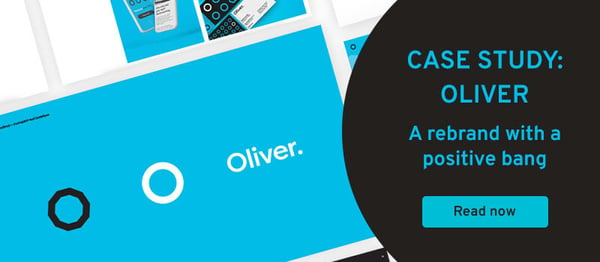It's easy to think that if your company is successful, you don't need to change your branding strategy. But as we've seen with companies like Blockbuster and Blackberry, even the most well-known brands will fail without an effective and relevant plan.
We've compiled some of the most common signs that your brand strategy is failing and other branding issues for you. This post will give you an idea of how to fix them before it causes any major problems in the future.

You don’t stand apart from your competition: brand problems with positioning
If your competitors put their logo on your brand, would anyone notice? The secret to having your brand be distinct from your competition is to know where you stand in the marketplace.
To do this, you need a solid positioning strategy. At Major Tom, we treat positioning strategy with a three-pronged approach:
- Understanding your audience
- Knowing your competitors
- Finding your difference
To gain an understanding of these three things, we can facilitate workshops with you and your stakeholders, and perform marketplace analysis and research, and client and stakeholder interviews. Without these steps, you’re putting assumptions over research — which results in common but harmful brand issues. After consolidating our findings, we’re able to craft a positioning statement that encapsulates your niche.
A good positioning statement may frame your value proposition and why it matters to your ideal consumers. For example, back when Netflix first launched, their positioning statement was “To provide a comprehensive selection of niche or unpopular movies at extraordinary convenience with customizable experience.” Of course, their position today is much different but you can see how their success may have come from leaning into this niche in their early days.
To craft a compelling and accurate positioning statement, you first have to know your brand’s substance — you can see the full approach we take to brand books here.
You don’t know your purpose or values: branding issues with inauthenticity
Are things feeling inauthentic? Are you creating campaigns or assets that only serve to answer a trend? Your branding issues may be with trying to be too on-top of trends without good reason. There’s a big difference between acting on trends and acting for trends. Being proactive in the marketplace and identifying trends that can work with or for your brand is great. Jumping on trends because you think it will gain more likes is not.
Pepsi’s Black Lives Matter Kendall Jenner-fiasco comes to mind. This tone-deaf campaign failed for many reasons but, to reduce it to very simple terms, Pepsi’s marketing campaign didn’t match their brand purpose. They tried to profit off of a human rights movement their brand had nothing to do with; ultimately, they paid the price in public backlash and apologized.
While this example is extreme, other brand problems can stem from not accurately defining your values or purpose. You can think of your brand values as a rudder for your entire organization. Use them as the standard you hold your employees and your organization against when making decisions. A brand without values is a rudderless organization.
Think of your brand purpose as a guide that shapes your brand — it answers the questions:
- Why do you do what you do, besides commercial gain?
- What is your reason for getting out of bed in the morning?
Look at Dove for inspiration. Their website states, “We believe beauty should be a source of confidence, and not anxiety.” and their actions support this belief. You can trace everything Dove does back to its purpose.
To execute authenticity, remember this simple life advice: Don’t do what you think people want. Do what makes sense for your brand.
Your brand lacks cohesion: A brand identity issue
Do your brand assets vary from platform to platform? Is the visual story you’re telling on your website calm and blue while your social media feed is full of exciting reds? It sounds like you lack brand cohesion. A strong brand identity will fix this issue.
Your brand identity stretches beyond the visual. Think about your brand voice and your core messaging. How you speak and what you say also shape your brand in the mind of your audience.
As Major Tom’s creative director Darren Maher likes to say, “cohesion breeds credibility.” Cohesive branding helps you to control the first impression you want to have on potential consumers by showing and telling the same story across all of your touchpoints. By staying consistent, you build brand equity — when you think of red and yellow, what do you think of?

Your marketing plan, strategy, and efforts are the same as they always were
So, in the past, your branding has been successful. And now, you (or your leadership team) make decisions based on that past success, not future trends. This decision-making trap is easy to fall into. But, because your competitors are doing new things and your audiences are looking for new things, you’ll quickly become a second choice.
If you’ve grown but your brand has stayed the same, it’s time to reevaluate. Your brand should evolve alongside your company as you grow in size or age or change your business model. And, how much you have changed or how much you would like to change will determine how much work you should do on your brand, whether that’s a full rebrand or a brand refresh.
Think of Netflix: They evolved from a DVD rental company to forerunners of the streaming-subscription models we know and love today. And, their brand evolved alongside — though their iconic black and red have remained the same, the rest of their assets (voice and visual) have changed alongside. Practicing what we preach, we even went through a brand evolution a few years ago.
You only have to think about old brands like Blockbuster to see what a lack of innovation and action leads to. Though, as with resurgent brands like Polaroid, if Blockbuster could rebrand as a vintage blast-from-the-past they may have a fighting chance to pull in a nostalgic audience. A complete comeback is doubtful — but that doesn’t mean impossible.
Do you have more branding questions?
We can help. Whether you’re looking for the market cost of branding services, how Major Tom approaches branding as a whole (no secrets here), or a guide on how to best implement your brand book once completed, we have the answers to your branding questions. Contact us today.